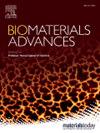受血管化管状骨结构启发的解剖形状骨模型的3D打印
IF 5.5
2区 医学
Q2 MATERIALS SCIENCE, BIOMATERIALS
Materials Science & Engineering C-Materials for Biological Applications
Pub Date : 2025-05-13
DOI:10.1016/j.bioadv.2025.214348
引用次数: 0
摘要
在新形成的骨中建立早期血管网络对于其存活和工程骨移植物在生物体中的成功整合至关重要。为了应对这一挑战,我们受生物血管化原理的启发,在三维(3D)组织结构中设计了具有集成微通道的骨支架。利用3D打印技术,这些结构复制了天然骨血管网络,包括Haversian和Volkmann动脉,显示出再生大规模骨缺陷的巨大潜力。我们设计并制作了三组结构,微通道垂直定向(模型A)、垂直-水平(模型B)和垂直-水平-径向-中心排列(模型C)。微观结构成像显示,3D打印促进了具有中空微通道的仿生结构的发展,密切模仿天然骨骼的血管网络。力学试验结果表明,A、B、C结构的抗压强度分别为51、41、37 MPa。重要的是,所有的微通道保持畅通,促进了结构内类似血液的液体的运输。这些结构支持MG63细胞在海绵区和人脐静脉内皮细胞(hUVECs)沿通道有效共培养,证明了它们支持细胞组织和血管化的能力。总的来说,我们的研究为设计和评估专门为血管化骨工程设计的创新型3D仿生支架提供了一个通用的框架。在设计的模型中,垂直-水平-径向-中心排列的C模型因其独特的特性和紧密的血管网络而脱颖而出,非常适合在骨组织工程中的高级应用。本文章由计算机程序翻译,如有差异,请以英文原文为准。
3D printing of an anatomically shaped bone model inspired by vascularized tubular bone structure
Establishing early blood vessel networks within newly formed bone is vital for its survival and the successful integration of engineered bone grafts in living organisms. To tackle this challenge, we designed bone scaffolds with integrated microchannels within three-dimensional (3D) tissue structures, inspired by the principles of bio-vascularization. Using 3D printing, these structures replicate the natural bone vascular network, encompassing Haversian and Volkmann's arteries, showing significant potential for regenerating large-scale bone defects. We designed and fabricated three groups of structures with microchannels oriented vertically (Model A), vertical-horizontal (Model B), and in a vertical-horizontal-radial-central arrangement (Model C). Microstructure imaging revealed that 3D printing facilitates the development of bio-inspired structures with hollow microchannels, closely mimicking the vascular network of natural bone. Mechanical testing showed compressive strengths of 51, 41, and 37 MPa for structures A, B, and C, respectively. Importantly, all microchannels remained unobstructed, facilitating the transport of a blood-like fluid within the structures. These structures supported effective co-culture of MG63 cells within the spongy region and human umbilical vein endothelial (hUVECs) along the channels, demonstrating their ability to support cellular organization and vascularization. Overall, our research offers a versatile framework for designing and evaluating innovative 3D bio-inspired scaffolds specifically engineered for vascularized bone engineering. Among designed models, model C with vertical-horizontal-radial-central arrangement stands out due to its unique features and cohesive vascular network, making it highly suitable for advanced applications in bone tissue engineering.
求助全文
通过发布文献求助,成功后即可免费获取论文全文。
去求助
来源期刊
CiteScore
17.80
自引率
0.00%
发文量
501
审稿时长
27 days
期刊介绍:
Biomaterials Advances, previously known as Materials Science and Engineering: C-Materials for Biological Applications (P-ISSN: 0928-4931, E-ISSN: 1873-0191). Includes topics at the interface of the biomedical sciences and materials engineering. These topics include:
• Bioinspired and biomimetic materials for medical applications
• Materials of biological origin for medical applications
• Materials for "active" medical applications
• Self-assembling and self-healing materials for medical applications
• "Smart" (i.e., stimulus-response) materials for medical applications
• Ceramic, metallic, polymeric, and composite materials for medical applications
• Materials for in vivo sensing
• Materials for in vivo imaging
• Materials for delivery of pharmacologic agents and vaccines
• Novel approaches for characterizing and modeling materials for medical applications
Manuscripts on biological topics without a materials science component, or manuscripts on materials science without biological applications, will not be considered for publication in Materials Science and Engineering C. New submissions are first assessed for language, scope and originality (plagiarism check) and can be desk rejected before review if they need English language improvements, are out of scope or present excessive duplication with published sources.
Biomaterials Advances sits within Elsevier''s biomaterials science portfolio alongside Biomaterials, Materials Today Bio and Biomaterials and Biosystems. As part of the broader Materials Today family, Biomaterials Advances offers authors rigorous peer review, rapid decisions, and high visibility. We look forward to receiving your submissions!

 求助内容:
求助内容: 应助结果提醒方式:
应助结果提醒方式:


